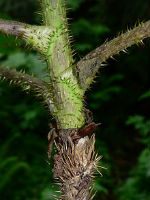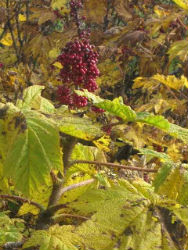Devil's Club
what hurts can heal
I’ve been gone, and now I’m back. Once again, we’re in in-between time. Beltane, halfway between equinox and solstice. So much transition energy, and aside from the facts (which are extraneous to this particular post), I’m in the nonverbal experiential stage right now.
It’s not that I’m at a loss for words; more that it seems premature to put words to what’s morphing and shifting, for myself and for many in my weave, right now.
Resuming now, we were two-thirds through a spell to do with devils and slanderous spirits, who are not necessarily malign. So, here is the "plant" part, which is devil’s club.
Devil’s club isn’t local to me now, but it was when I lived in Alaska. I had the intention to dig root bark and tincture it, but that never happened (for reasons that may become obvious). In early spring (which is late May-early June up in AK), I harvested the young thumb-sized leaf buds, careful not to take too many from a single plant. A little too astringent to eat raw, I served them steamed and dressed with coconut oil and sea salt; in their slightly thistly soft munchiness they resembled mini artichoke hearts.
The scientific name is oplopanax horridus, which means “bristling all-healing club.” The “all-healing” part is the word “panax,” like panax ginseng, and another common name is Alaskan ginseng. But it’s unrelated to ginseng; it’s in the araliaciae family, like spikenard (which I love, and which is within reach of Tucson).
This tall perennial shrub is native to the Pacific Northwest and all the way up to southcentral Alaska, as well as in isolation on islands in Lake Superior. It’s notable that just about all the native peoples who lived where devil’s club grows had a name for it and used it.
And not only did they use it; they used it for everything, from psychic protection to joint/arthritic issues (in the tradition of using prickly/stinging substances for those issues, like nettles, bee venom) to blood sugar regulation to purging to skin and lung issues, and much more.
And they used all parts of the plant, in many different preparations, both topically and internally. This is an old but great article about the native uses.
Justly called a panax aka panacea/cure-all, then. And it was food, as I mentioned, and was also used to make paint. Modern studies have showed it effective against tuberculosis and leukemia.
So, why did I never get around to digging up some root? I knew that the plant is fragile to disturbance, but it grew in such superabundance where I lived that a little bit of lateral root wouldn’t have harmed anything.
No, but nowadays its superabundance is almost universally considered a curse, not a blessing, because of the “horridus” part of its name. Never mind the devil, “bristling” is an understatement! It is prickly from a through z, from roots to trunks to leaves to leaf stalks, even around the berries. And they’re the kind of thorns that don’t pull out easily. If you don’t get tweezers to them fast, you’ll have to wait for the skin to work them back out.
I remember bushwhacking through some forest across the bay from Homer, rife with fallen spruce logs splayed all around with devil’s club, careful not to grab a devil’s club limb for balance… Walking along a fallen spruce long, threading my way through the thick vertical growth, and then a devil’s club limb worked loose and rebounded like a spring, hitting me on the forehead!
Clubbed, for sure. But really not traumatized at all, just brought very much into the present moment.
I appreciate this plant, along with nettles and the others--cactus around here, for sure, for reminding me that something painful or challenging can also be curative, bracing, mindfulness-inducing.
Perhaps this kind of medicine will be a good ally to us in this transitional time.
About the Author
Ela Harrison
Ela is a wordsmith and herb lover who has lived in many places and currently resides in Tucson, AZ.
